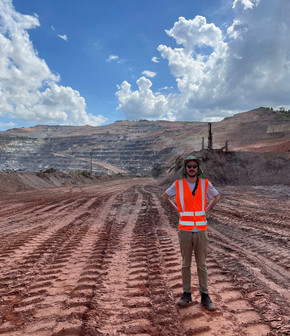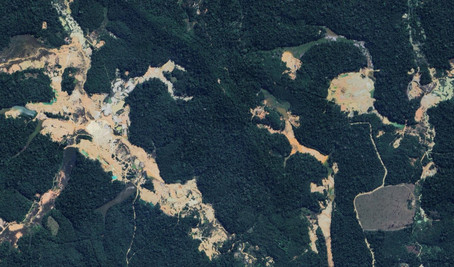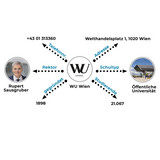Mining in Brazil: An environmental burden, but no stable income for municipalities
WU researchers Sebastian Luckeneder and Victor Maus are investigating the economic effects and ecological consequences of mining in Brazil.
Mineral resources such as iron and coal are crucial to the global economy. According to a report by the United Nations Environment Program (UNEP), global resource use has surged in recent decades. Rising income levels and growing consumption – from smartphones to cars – are driving global demand for minerals, which also form the basis of digitalization and the expansion of renewable energy systems. The raw materials are mostly mined in countries of the Global South, where mining is a major cause of deforestation, alongside soy, palm oil, and pasture farming. But does it truly provide stable income for the local economy, or just quick money and long-term problems?

Sebastian Luckeneder in front of a mine in Brazil
From a hilltop, you can see the crater in the mountain. Excavators drive up and down the terraced slopes. “Just the sight of the stripped mountainside and the discolored water makes it clear: Mining is a massive intrusion on the environment,” says Sebastian Luckeneder, a visiting researcher at WU Vienna’s Institute for Ecological Economics, describing a visit to an iron ore mine in Brazil. The Itabira mine is located in the state of Minas Gerais, which means “general mines” in English, because it is rich in coveted mineral resources.
Informal mining as a driver of deforestation
The Itabira mine alone extracts 40 million tons of metals annually. That is equivalent to about 80 fully loaded container ships the size of the Ever Given, which got stuck in the Suez Canal in 2021. The massive scale of the Itabira mine highlights the impact of mining on the landscape. In addition to industrial mining using heavy machinery, informal small-scale mining – known as “garimpo” – is also prevalent in Brazil. This is informal, sporadically regulated mining with weak environmental regulations, often taking place outside of what is legally permitted. In a new study, WU researchers and colleagues from IIASA and the University of São Paulo are using satellite images to investigate forest loss due to mining. The results show that garimpo mining in particular leads to deforestation. “Satellite images of the Amazon show how mining is eating away at the rainforest, even in areas that were previously inaccessible,” says Luckeneder.
Short-lived economic gains
The researchers integrate satellite imagery with economic data to assess the ecological and economic impacts of mining in Brazil at the municipal level. “Our results show that the economic boom is short-lived in many regions,” explains Luckeneder.
Before 2010, when global commodity prices were high and demand was strong, mining communities and – due to labor market and economic multiplier effects – their neighboring regions experienced above-average economic growth. However, after prices fell in 2010, the situation changed in many areas: The same mechanisms that had previously driven growth now resulted in economic stagnation and crisis – often extending beyond the mining municipalities. The researchers draw a clear conclusion: Neither industrial nor informal mining constitutes a sustainable development strategy.
Calls for stricter regulation of informal mining
Politics plays a key role in minimizing the environmental impact of mining. In the study, the researchers call for stricter legal regulation of informal mining, robust ecological and social protection measures, and the restriction and monitoring of mining activities, especially in sensitive ecosystems such as the Amazon region. Mining will continue to play an important role in the future, as metals and minerals are also needed for the construction of electric cars, wind turbines, and solar panels. “But the question is: Where will they be mined, and above all, for what purpose? For building more environmentally friendly energy systems or for making even more private cars?” says Sebastian Luckeneder.

Satellite image of a mining area in Brazil © Google / Airbus, CNES, Maxar Technologies
Sources
UNEP Global Resources Outlook 2024: Report on the global use of raw materials
Visualization tool with spatially explicit data on global land use by mining



![[Translate to English:] Sebastian Luckeneder in Brasilien](/fileadmin/wu/_processed_/e/8/csm_seb-itabira1_3c69898a0e.jpg)
